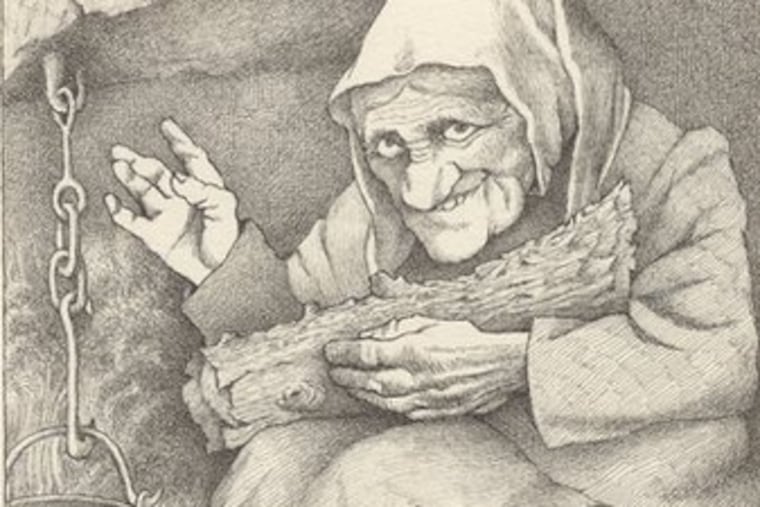'Dreadful Things Happen': The spooky power of Sendak
The summer exhibit "Dreadful Things Happen: The Brothers Grimm & Maurice Sendak" at the Rosenbach Museum and Library is remarkable for its spooky power.

The summer exhibit "Dreadful Things Happen: The Brothers Grimm & Maurice Sendak" at the Rosenbach Museum and Library is remarkable for its spooky power.
Featured are 40 original Sendak artworks, each with an intense emotional charge in its story line. These book illustrations, and several related storybooks for viewers to leaf through, are the stuff of nightmare and fantasy, wicked parents, magic and witchcraft, secrets and fears.
Sendak's real strength - in illustrations both for his own books and for the various 200-year-old Grimm texts - is his ability to fuse tradition's authority with the intensely personal; we can sense inside his artistry another, unreachable world.
Sendak's art tends to be presented in solo shows, but this display reflects the influence of other artists and other times, which helps to get him more clearly in our sights. He certainly isn't following a vogue, nor has he fenced himself into a position. Scholars of language, the brothers Jacob and Wilhelm Grimm collected European folktales and myths going back beyond medieval times. They provide Sendak with opportunities to explore the harmonious, deep recesses of his own work. He took pains to examine and update their cultural settings with impressive research of his own before illustrating the tales.
The high quality of these drawings, often done in pen and ink so finely wrought they could be mistaken for etchings, is astonishing. No arid series of exercises, they prod our feelings and make us intensely conscious of whatever we're seeing. (Their premonitions and other dark imaginings are summed up in the fey ugliness of Sendak's wonderful character study of a witch, Mrs. Gertrude, who has just turned a girl into a log to toss on a fire.)
The mystery of this show's references entices adults and children alike, engaging us rather like a cabinet of curiosities - yes, like the storied Melville Greek Revival tall cabinet at the entrance to "Dreadful Things Happen."
Wilmington wonder, Part I
For the second time in five years, we welcome the sponsorship by the Delaware Center for the Contemporary Arts of a curated contemporary color abstraction show. Featured in "Spectrum" are 16 invited regional artists, mostly painters and a few sculptors. Even the limited evidence presented here seems to prove curator J. Susan Isaacs' point that, far from being on life support, both painting itself and color abstraction in particular contribute "a healthy, robust voice to the art of the 21st century."
Initially, I was struck by several large works - Paul DeMuro's startling behemoth of a piece, its welters of paint deftly suggesting fraying standards of living, and the ordered turmoil of E.J. Herczyk's strong and suggestive patterns, richly achieved digitally in Leviathan II. By contrast, Melanie Carr's Concentric Bumps in fresh, spring-clean colors in mixed media glancingly admits that 3-D color is fun, while the precision of stroke in Mike Nemire's outstanding oil Origin gives a lively sparkle to that shimmering grid.
Bill Scott, also concerned with color sensation, offers shimmering effects of light that are lyrical, diaphanous, sensual. Declaring in contrast the artist's marked urge for order and discipline in placement is Jonathan Schoff's Hallway oil, one of the few partial abstractions. Another of these, noteworthy for an almost playful disorder, is the expert "scribbling" of Gretchen Batcheller's Father's Day Route painting.
Meanwhile, quite accomplished is a painted wood piece by Dennis Beach, Bump #2, with its crisp rhythms and tonic quality. Steven Baris' series of paintings on Mylar offers bland, quiet pleasure and muffled, softly blurred color, while Lee Arnold's colored-pencil series Who's Afraid of Red Yellow Blue and Green captures an astonishing quality of thin line and feel for subtle color and design. A very memorable show.
Wilmington wonder, Part II
Ellen Priest goes solo at the Delaware Division of the Arts Mezzanine Gallery in the Carvel State Office Building. A painter (with a master's from Yale Divinity School), Priest deliberately blurs the boundary between painting and jazz in her
Venezuelan Suite
painted collages. These use form as a language of music, as she angles and interlocks long, curling cornucopias of color to form a network of diagonals that move in and out of space over whole images. Seeing jazz as full of joy and energy, able to transform sadness, Priest uses it successfully here to create materialized movement in actual worlds of colored space.